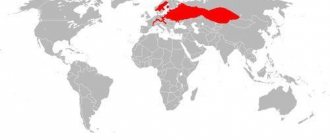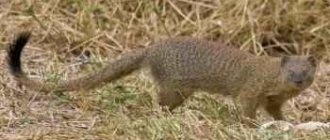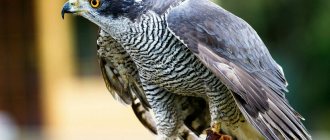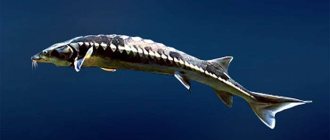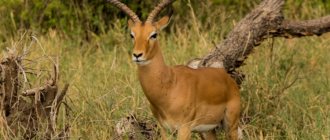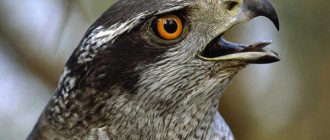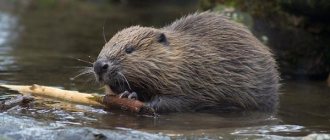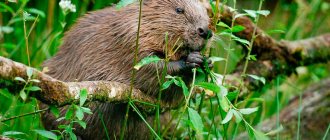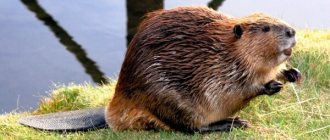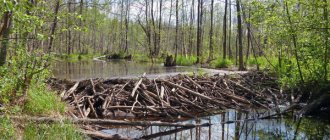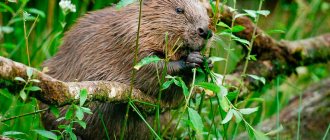Description of the rodent
— Advertising —
The beaver's body weight is about 30 kg, the body length reaches 1-1.5 m, females are usually slightly larger in size than males. The rodent has a blunt muzzle, small ears, short, strong legs with powerful claws. The beaver's fur consists of two layers: on top there are hard red-brown guard hairs, and underneath there is a thick gray undercoat that protects the beaver from hypothermia. The tail is bare, black, flattened and wide, covered with scales. Near the base of the tail are two glands that produce an odorous substance known as “beaver squirt.”
Beavers' eyelids act as glasses and their tails act as alarms.
Beavers are incredibly well adapted to the life of a dam builder. Much better than it might seem at first glance. They have clear eyelids that act like goggles and valves that cover their nostrils and ears while diving.
Beaver teeth are orange due to their high iron content, which makes them strong. In addition, their cutters are not uniform: the back of the edge is stronger than the front, which gives the effect of a self-sharpening blade. The beaver's tail not only works as an oar and fat storage, but also serves as a kind of stand-chair when it stands on the shore. It can also serve as a siren: a beaver that senses danger hits the water with its tail, and this sound alerts its buddies hundreds of meters around.
Beaver nutritional features
Beavers are herbivorous rodents. Their diet includes bark and shoots of trees (aspen, willow, poplar, birch), various herbaceous plants (water lily, egg capsule, iris, cattail, reed). They can also feed on hazel, linden, elm, and bird cherry. They readily eat acorns. Large teeth and a strong bite help beavers to eat fairly solid plant foods, and the microflora of their intestinal tract digests cellulose foods well.
The daily required amount of food reaches 20% of a beaver's weight.
— Advertising —
In the summer, the diet of beavers is dominated by grassy food; in the fall, rodents actively prepare woody food for the winter. Each family stores 60-70 m3 of wood. Beavers leave their reserves in the water, where they retain their food quality until the end of winter.
Beaver tail tastes like roast beef
Those in the know say that properly cooked beaver tail tastes like roast beef, that is, baked beef. The only problem is that it is quite gristly, and if prepared improperly, eating it can turn into torture. In addition, we must take into account that it is in the tail that the beaver stores fat and nutrients: in winter it is twice as thick, like a piece of pig, and in summer it is like an oar.
Common Beaver Species
Common or river beaver (Castor fiber)
The body length is 1-1.3 m, height is about 35.5 cm, weight is in the range of 30-32 kg. The body is squat, the paws are shortened with five fingers, the hind legs are stronger than the front ones. Swimming membranes are located between the fingers. The claws are strong and flat. The tail is paddle-shaped, flat, reaches 30 cm in length and 10-13 cm in width. The tail is pubescent only at the base, the rest of its surface is covered with horny scutes. The eyes are small, the ears are wide, short, and slightly protrude above the fur. Under water, the ears and nostrils close, and the eyes have special nictitating membranes. The common beaver has beautiful fur made up of coarse guard hairs and a thick, silky undercoat. The coat color ranges from light chestnut to dark brown, sometimes black. The tail and paws are black. Molting occurs once a year.
In the anal area there are paired glands, wen and the so-called “beaver stream”, the smell of which is a guide for other beavers, as it informs about the border of the family’s territory.
The common beaver is distributed in Europe (Scandinavian countries, France, Germany, Poland, Belarus, Ukraine), Russia, Mongolia and China.
Canadian beaver (Castor canadensis)
Body length 90-117 cm; weight about 32 kg. The body is round, the chest is wide, the head is short with large dark ears and bulging eyes. The coat color is reddish or blackish brown. Tail length 20-25 cm, width 13-15 cm, oval shape, pointed end, surface covered with black horny scutes.
The species is distributed in North America, Alaska, Canada, USA, and Mexico. It was introduced to the Scandinavian countries and Russia.
Economic significance for humans
Positive
Eurasian beavers have valuable fur, meat and beaver stream. Previously, skins were used as currency until the animals almost disappeared. Fur was used to make clothing, felt, and felt hats. Beaver stream was used as a medicine and a base in perfumery. Beaver meat has nutritional value. In the 16th century, the Pope argued that the beaver's scaly tail and semi-aquatic lifestyle made it a fish and could be eaten during Lent. Even today, in Europe, about 400 tons of beaver meat are consumed during Lent.
Negative
Common beavers are considered destroyers, cutting down trees and flooding areas. The most numerous complaints are related to flooding of agricultural lands and, as a result, destruction of crops. Beavers flood roads and drainage pipes, causing serious damage.
Beaver behavior
Beavers usually live along the banks of forest rivers, streams and lakes. They do not live on wide and fast rivers, as well as reservoirs that freeze to the bottom in winter. For these rodents, tree and shrub vegetation along the banks of reservoirs and an abundance of aquatic and coastal herbaceous vegetation are important. In suitable places, they build dams from fallen trees, construct canals, and use them to float logs to the dam.
Beavers have two types of housing: a burrow and a hut. The huts look like floating islands made of a mixture of brushwood and mud, their height is 1-3 meters, their diameter is up to 10 m, the entrance is located under water. Beavers spend the night in such huts, store food for the winter, and hide from predators.
Beavers dig burrows on steep and steep banks; these are complex labyrinths with 4-5 entrances. The walls and ceiling are leveled and compacted. Inside, at a depth of up to 1 m, a living chamber is arranged up to 1 width and height 40-50 cm. The floor is located 20 cm above the water level.
Beavers are excellent swimmers and divers; they can stay underwater for 10-15 minutes and swim up to 750 m during this time.
Beavers live either alone or in families of 5-8 individuals. The same family has occupied their plot for many years. Beavers do not walk 200 m from water. Rodents mark the boundaries of their territory with a beaver stream.
The main periods of beaver activity are night and twilight.
Where does the common beaver live?
You are welcome...
The historical range included the entire forest-meadow zone of the Eurasian continent. The current distribution area of the species covers Scandinavia, Great Britain, central and eastern Europe, some regions of the Far East, northern China and Kazakhstan.
Where live
The natural habitat of the common beaver is lakes and rivers with a large amount of coastal vegetation, including trees and shrubs. Rodents prefer forest reservoirs, as well as small rivers without rapid currents, but can also be found in deep rivers.
An unsuitable habitat for a beaver is a coastal zone near a shallow, freezing and severely drying body of water. Animals also avoid areas with significant changes in water level during floods and floods.
Beaver breeding
Beavers are monogamous rodents. Breeding occurs once a year. The mating season begins in mid-January and lasts until the end of February. Pregnancy lasts 105-107 days. One litter contains 1-6 cubs, which are born in April-May. Babies are born semi-sighted, well-furred, and their weight is approximately 0.45 kg. After a few days they can already swim. The female teaches them to swim, pushing them out of the hut into the underwater corridor. At 3-4 weeks, the beaver cubs begin to eat leaves and stems of grass, and until 3 months the mother feeds them with milk. The young live with their parents until they are two years old, after which they reach puberty and begin an independent life.
In captivity, the lifespan of beavers is up to 35 years, in the wild it is 10-17 years.
The beaver is not a hard worker, but a lazy one
The beaver is a born builder, literally. For him, building dams is not the conscious work of a hard worker, but almost a mania. He works on instinct: if a young beaver is placed in an enclosure where there is no running water or even trees, he will still try to build a dam. He is also able, without much effort, to fell a tree with a diameter of 16 cm in an hour. And with all this, the beaver is a rather lazy beast. In winter, for example, he leaves his hut no more than once every two weeks, preferring to relax and snore.
Interesting facts about the rodent:
- The common beaver is the largest rodent in Europe and the second largest in the world after the capybara.
- The word "beaver" comes from an Indo-European language and is an incomplete duplication of the name for the color brown.
- Until the middle of the 20th century, beaver fur was very popular in America, Europe and Russia, which is why the population of these animals decreased noticeably: there were 6-8 isolated populations of 1200 individuals left. To preserve the species, beaver hunting was prohibited. Currently, the common beaver has a minimal risk status, and the main threats to it are land reclamation activities, water pollution and hydroelectric power plants.
- In addition to beautiful and durable fur, beavers are a source of beaver stream, which is used in perfumery and medicine. Beaver meat is also edible, but may contain salmonellosis pathogens. According to church canons, it is considered fasting.
- In 2006, a beaver sculpture was unveiled in the city of Bobruisk (Belarus). There are also sculptures of this rodent in the Alpine Zoo (Innsbruck, Austria).
Role in the ecosystem
Common beavers have an extraordinary ability to impact ecosystems. Through the process of building dams, they change the flow of water, which leads to the flooding of many hectares of forest land. The decrease in nitrogen and acidity along with the increase in carbon inhibits the growth of woody vegetation for some time, but eventually the trees begin to grow and the forest recovers. Dams collect waste and debris, which increases carbon and decreases nitrogen and acidity, altering invertebrate habitats. This new source of water attracts various species of birds, fish and amphibians. River beavers also control woody vegetation. Submerged wood dies within a year and then becomes part of the aquatic ecosystem.
River beavers act as hosts for 33 different species of ticks, which can live on rodents at any time of the year.
Features of character and lifestyle
Photo: European river beaver
A beaver can swim in water for a long time. On land it is very slow and moves rather poorly. But in the water he feels complete freedom. When diving, it can stay under water for up to 15 minutes. When diving, the ears and nasal passages are immediately closed by a special partition. And the eyes are covered with a film that is transparent. Thanks to this, the beaver can see well underwater. It can swim a long distance underwater - up to 1 km.
The beaver is distinguished by its peaceful character and tries to flee when danger appears. But if there is nowhere to run, he can enter into a fierce battle, and then the enemy will suffer.
When an animal sees, hears (although it has small ears, it has excellent hearing) or feels danger, it will immediately try to dive under the water. At the same time, he tries to slap loudly with his wide tail. This is not out of clumsiness, but specifically to warn their relatives about the danger. And only after a while, when air is needed, his head appears above the surface of the water. Important to know: The beaver is the only animal among all rodents that can move on both its 4 and hind legs. In them he can even carry stones to build his home.
The beaver is a very clean animal. You will never see any trash in his house. He builds his home in such a way that even in the most severe frost there will be above-zero temperatures. You can understand exactly where these rodents spend the winter thanks to the steam that rises through the holes in the ceiling of this house. By the way, they are trying to insulate it well. To do this, they bring clay with their front paws and cover the branches on top. They leave their home only after dusk, and work until the morning. Their teeth are so sharp that one beaver can completely gnaw through an aspen trunk, the diameter of which is up to 15 cm, in just half an hour.
Lifestyle
Beavers constantly live near water. Their favorite habitats are cluttered, slow-flowing or stagnant forest reservoirs. The decisive factor for the settlement of a particular reservoir is the availability of food - trees and shrubs. Willow and aspen forests are more loved by animals. The rodent avoids large rivers with high floods, since its home may be flooded.
Beavers lead a sedentary lifestyle. For most of the year they are active in the twilight-night time, leaving their shelters at sunset and returning at dawn. In winter in northern latitudes, when the dams are covered with ice, the animals remain in huts or under the ice all the time, since the temperature there remains around 0 ° C, while outside it is much colder.
On land, the beaver gives the impression of a slow and clumsy animal when it waddles, relying on large, clubbed hind legs and short front legs. However, in case of danger, he rushes to the water at a gallop.
Among all rodents, our hero is best adapted to movement in water. Its torpedo-shaped body is streamlined, and its fur is waterproof. It slowly swims near the surface of lakes, slowly moving its paws, while its tail serves as a kind of rudder. When diving or swimming at high speed, the rodent sharply swings its tail up and down and at the same time rows with its hind legs.
Like a woodcutter's axe, the front enamel of a rodent's teeth is especially reinforced. The softer back surface grinds down faster, creating a sharp chisel-shaped edge that makes cutting trees easier. With its sharp incisors, the animal can gnaw and knock down a tree up to one meter thick. Like all rodents, beavers have large incisors that grow at the same rate as they wear down.
In the photo, the beaver shows off its unique incisors.
This is what a rodent can do to trees
Dams and huts
Everyone has probably heard about the amazing construction talents of these animals. Thanks to their tirelessness, beavers have learned to adapt the environment to their own needs. The dams they create increase ecological diversity, expand water areas, increase the volume and quality of water, and modify the landscape. A tree that has fallen across the current is usually used as the basis for a dam. It is filled with branches, parts of tree trunks, stones, earth, and vegetation until the length of the dam exceeds 100 meters (the edges of the dam extend far beyond the channel), and the height often reaches three meters. In this case, the difference in water level reaches two meters. It happens that a family builds several dams at once, resulting in a whole cascade of ponds. Rodents are especially zealous in the construction of dams in spring and autumn, although work can continue all year round.
Beaver Dam
Beavers are skilled diggers. They usually dig numerous holes on a family property, which can be either simple tunnels or entire labyrinths leading from the bank of a stream or dam to one or more chambers. In many biotypes, these rodents use burrows as their main shelters.
This is what a beaver's hut looks like
Another option for a coastal dwelling is a hut. Beavers build them in places where making burrows is impossible. Animals use an old stump, low bank or raft as the base of the hut. Externally, such a dwelling is a large pile of branches, pieces of tree trunks, held together by earth, silt, and plant debris. A nesting chamber is set up inside, from where it goes under water. On average, the diameter of the hut reaches 3-4 meters. More complex structures have several chambers at different levels. Huts can be temporary or permanent, used over many years. The latter are constantly being completed and can reach 14 meters in diameter and more than two meters in height.
Among beavers' other construction activities, channel digging is the least difficult. With their front paws they scoop out silt and dirt from the bottom of small streams and swamp paths, throwing them to the sides from their path. The resulting channels allow animals to remain in the water while moving between dams or to feeding areas. Rodents mostly do this in the summer, when the water level is low.
It is worth noting that Canadian beavers are more diligent and active builders than ordinary beavers. Their buildings are more complex and durable, since they actively use stones in construction.
Diet
Beavers are exclusively herbivorous animals. The composition of their food may change seasonally. In spring and summer, the basis of their diet consists of leaves, roots, grasses, and algae. By autumn, they switch to thin branches of trees and shrubs, preferring aspen, willow or alder.
Starting from mid-October, rodents begin to prepare woody food for the winter. These can be thick branches and even parts of the trunks of aspen, willow, bird cherry, alder, birch, as well as a small number of conifers. Animals cut felled trees into small pieces and store them under water in deep places near burrows and huts. Beavers can swim to their supplies underwater without leaving the safety of the dam.
If there is not enough tree food, the animals are content with wetland vegetation. Sometimes raids on nearby gardens and vegetable gardens are possible.
Many European beavers do not store food for the winter. Instead, they also go ashore in search of food in winter.
Castoreum
A characteristic feature of the animals is the presence of a “beaver stream” produced by special glands. It is a complex substance consisting of hundreds of components, including alcohols, phenols, salicylaldehyde and castoramine. The scientific name of this substance is castoreum.
Since ancient times, beaver streams have been attributed supernatural healing properties. In the Y-IY centuries BC. Hippocrates and Herodotus noted its effectiveness in the treatment of certain diseases. And today this substance has found use in folk medicine, but it is mainly used in perfumery.
The beaver itself uses its aromatic secretion for marking purposes. Scent marks are one of the ways our heroes exchange information. Both the Canadian and river species leave scent marks on mounds constructed near the water from silt and plants raised from the bottom of the reservoir.
Family relationships
Most often, beavers live in family groups (colonies), but there are also individuals that prefer a solitary lifestyle. On lands poor in food, the proportion of solitary animals can reach up to 40%.
A family consists of an adult pair, the current year's cubs, last year's cubs, and sometimes one or more juveniles from previous litters. Family sizes can reach 10-12 individuals.
The hierarchy in the colony is built according to age, with the dominant position of the adult couple. Displays of physical aggression are rare, although beavers may have scars on their tails in dense populations. This is the result of fights with strangers near territorial borders.
The pairs of these rodents are permanent and remain throughout the life of the partners. The family group is stable, partly due to the low reproduction rate. They bring one brood per year, in it from 1 to 5 cubs for an ordinary beaver; in a Canadian beaver, fertility is higher - up to 8 cubs. However, most often there are 2-3 cubs in a brood.
The rut begins in January (in the south of the range) and lasts until March. Pregnancy lasts 103-110 days.
Newborns are sighted, densely pubescent, with erupted lower incisors. The mother feeds the babies milk (and it is 4 times fattier than cow's milk) for about 6-8 weeks, although already at the age of two weeks the beavers begin to taste the tender leaves brought by their parents. At the age of 1 month, the younger generation begins to slowly leave the nest and feed on their own.
While the children are very small, the father spends most of his time protecting the family plot: he patrols the borders and leaves scent marks. At this time, the female is busy feeding the babies and caring for them. Babies grow quickly, but they need many months of practice to master the skills of building dams and huts. Their parents teach them to participate in all family activities, including construction.
Usually, young people leave their family and go in search of their future site in the second year and lead a solitary lifestyle until they get a pair.
Beavers reach sexual maturity in the second year of life, but females usually begin breeding at 3-5 years of age.
The maximum life expectancy of the common beaver in nature is 17-18 years, the Canadian beaver is 20 years. However, in natural conditions they rarely live more than 10 years. The maximum age of these rodents recorded in the nursery reached 30 years.
Communication
In addition to marking territory, beavers communicate with each other by flicking their tails across the water. This is usually how adults tell strangers that they have been spotted. A rodent that has invaded an occupied territory makes a response clap, which allows one to assess the seriousness of its intentions and the degree of threat it poses.
Another way of communication is through various postures, as well as voice: animals can grumble and hiss.
Natural enemies
Despite the fact that beavers build homes that are inaccessible to predators, this does not mean that they have no enemies in their natural habitat. These rodents are exposed to the main danger on land, where they are much less agile and dexterous than in water. However, predators rarely hunt adult beavers, but they do not disdain young beavers. Among the main natural enemies of common beavers are wolves, foxes, brown bears, wolverines, lynxes, and otters. Coyotes, cougars, American black bears, also called baribals, and fishing marten, also known as ilka, are also not averse to hunting Canadian beavers.
In the southern regions of their range, Canadian beavers, although infrequently, can also be threatened by American alligators, and they are equally dangerous for beaver cubs and for their parents and already matured brothers and sisters. Birds of prey, such as kites or eagles, can also pose a danger to young beavers.
Return to content
Habitat
Beavers belong to the family Castaridae, which includes the only genus Castor and only 2 species:
- common beaver (Castor fiber) (also known as river or eastern beaver);
- Canadian beaver (aka North American) (Castor canadensis).
Today, North American beavers are found throughout the continent, from the mouth of the Mackenzie River in Canada south to northern Mexico. But it was not always so. People have hunted these animals for centuries for their meat, fur, and “beaver stream.” As a result, at the end of the 19th century, the number of Canadian individuals became critical, and in most of their habitats they were almost completely exterminated, especially in the eastern United States. State and local environmental agencies sounded the alarm, and animals began to be transported from other areas. They were also introduced in Finland, Russia, and a number of Central European countries (Germany, Austria, Poland). One of the largest populations of Canadian rodents today exists in southeastern Finland.
The common beaver in the past lived throughout Europe and Northern Asia, but not all populations were able to survive in the vicinity of humans. By the beginning of the 20th century, only a few relict populations with a total number of 1,200 individuals survived in France, Norway, Germany, Russia, Belarus, Ukraine, China and Mongolia.
As a result of programs for the reintroduction and resettlement of these animals, which began in the first half of the last century, the number of the common beaver began to gradually increase. At the beginning of the 21st century, there were about 500-600 thousand individuals, and their habitat expanded both in Europe and Asia.
Both species are found on the territory of Russia today, although the original inhabitant is only the river beaver. Its range covers almost the entire forest zone of the Russian Federation - from the western borders to the Baikal region and Mongolia, and from the Murmansk region in the north to the Astrakhan region in the south. In addition, this species has acclimatized in Primorye and Kamchatka.
The Canadian beaver appeared in our country in the 50s of the last century, independently populating Karelia and the Leningrad region from the adjacent regions of Finland, and in the 70s this animal was introduced into the Amur River basin and Kamchatka.
Spreading
Beavers inhabit the entire temperate zone of the Northern Hemisphere and are found in Europe, Asia and North America. In the north, the beaver's range borders on the forest-tundra, in the south – on the steppe zone. Beavers are aquatic animals, so they are found only on the banks of water bodies.
Most of all, these animals like small rivers with a quiet flow, streams, creeks, small lakes; beavers can also be found in wetlands of the forest. At the same time, these animals do not live in real (vast and treeless) swamps; you will not find a beaver on the banks of a mountain river, an endless lake, sea or ocean.
The reason for this selectivity is that beavers feed on woody vegetation, so one way or another, the reservoirs they inhabit are located in the forest. And here again beavers show their selective taste; they will not live in every forest. The main condition for beavers is that trees should grow as close to the water's edge as possible, which is why small forest streams and lakes buried in thickets are favored by these animals. Beavers will not settle in a slender pine forest, in a forest growing on a rocky or wide sandy shore.
Varieties
The beaver family has only two species: the common beaver, or river beaver, and the Canadian beaver. Let's take a closer look at the types of beavers.
- River. This is a semi-aquatic animal, the largest rodent in size, inhabiting the Old World, the forest-steppe zone of Russia, Mongolia, and China. They settle along the banks of slow-flowing rivers, irrigation canals, lakes and other bodies of water, the banks of which are covered with trees and bushes.
- Canadian. In appearance it differs from the river beaver in having a less elongated body, a short head and larger ears. The color is blackish or reddish brown. It lives throughout almost the entire United States (except for Florida and most of Nevada and California), in Canada, except for the northern regions. It was brought to the Scandinavian countries, from where it independently penetrated into the Leningrad region and Karelia.
These two beaver species have different numbers of chromosomes and do not interbreed.
